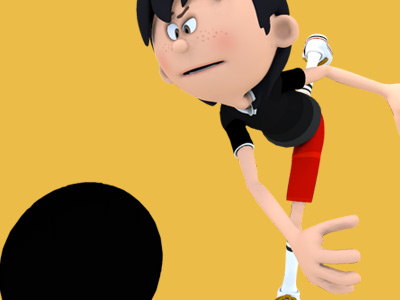Scoring
In general, one point is scored for each pin that is knocked over. So if a player bowls over three pins with the first shot, then six with the second, the player would receive a total of nine points for that frame. If a player knocks down nine pins with the first shot, but misses with the second, the player would also score nine. When a player fails to knock down all ten pins after their second ball it is known as an open frame.
In the event that all ten pins are knocked over by a player in a single frame, bonuses are awarded.
- Strike: When all ten pins are knocked down with the first ball (called a strike and typically rendered as an "X" on a scoresheet), a player is award ten points, plus a bonus of whatever is scored with the next two balls. In this way, the points scored for the two balls after the strike are counted twice.
-
- Frame 1, ball 1: 10 pins (strike)
- Frame 2, ball 1: 3 pins
- Frame 2, ball 2: 6 pins
- The total score from these throws is:
-
- Frame one: 10 + (3 + 6) = 19
- Frame two: 3 + 6 = 9
- TOTAL = 28
-
Two consecutive strikes are referred to as a "double strike" or a "rhino". Some locations still call it a "Hambone" even though that term has been changed to mean 4 strikes in a row by announcers on television. (Four strikes in a row is also referred to as a "Llama.")
A double's pinfall is:
-
- Frame 1, ball 1: 10 pins (Strike)
- Frame 2, ball 1: 10 pins (Strike)
- Frame 3, ball 1: 9 pins
- Frame 3, ball 2: 0 pins (recorded as a dash '-' or '0' on the scoresheet)
- The total score from these throws is:
- Frame one: 10 + (10 + 9) = 29
- Frame two: 10 + (9 + 0) = 19
- Frame three: 9 + 0 = 9
- TOTAL = 57
Three strikes bowled consecutively are known as a "turkey" or "triple".
A turkey's pinfall is:
-
- Frame 1, ball 1: 10 pins (Strike)
- Frame 2, ball 1: 10 pins (Strike)
- Frame 3, ball 1: 10 pins (Strike)
- Frame 4, ball 1: 8 pins
- Frame 4, ball 2: 2 pins (Spare)
- Frame 5, ball 1: 8 pins
- Frame 5, ball 2: 1 pin, but player stepped across foul line during throw (Foul)
- The total score from these throws is:
- Frame one: 10 + (10 + 10) = 30
- Frame two: 10 + (10 + 8) = 28
- Frame three: 10 + (8 + 2) = 20
- Frame four: 10 + 8 = 18
- Frame five: 8 + 0 = 8
- TOTAL = 104
Longer strings of strikes are called by various names, including "-Bagger" (Four Bagger), "Llama" (Four consecutive), and "-Pack" (Six Pack) depending on local use, equipment, and exposure to the sport. Recently, the event of bowling four consecutive strikes has also been called a "hambone". Six strikes and nine strikes in a row can also be referred to "Wild Turkeys" and "Golden Turkeys" respectively. Any string of strikes starting in the first frame or ending "off the sheet" (where all of a bowler's shots from a certain frame to the end of the game strike) are often referred to as the "front" or "back" strikes, respectively (e.g., the "front nine" for strikes in frames 1–9, or the "back six" for strikes in frames 7, 8, and 9 with a turkey in the tenth). A "perfect game" or 12 strikes in a row is also rarely referred to as the "Thanksgiving Turkey". A "Clean Game" is a game with strikes or spares in every frame (not counting bonus balls).
A small number of bowling fans have recognized that naming each strike in a consistent manner adds to the enjoyment and excitement of the game. Based on this, a growing number of bowlers subscribe to the "Duck, Duck, Turkey" method of titling consecutive strikes. In keeping with the tradition that the third consecutive strike is called a "Turkey," every third strike references turkeys and all strikes under this method have been named after birds as follows: Strike 1 - Duck; Strike 2 - Duck; Strike 3 - Turkey; Strike 4 - Goose; Strike 5 - Chicken; Strike 6 - Turducken; Strike 7 - Penguin; Strike 8 - Flamingo; Strike 9 - Turkey Vulture; Strike 10 - Woodpecker; Strike 11 - Eagle; Strike 12 - Turkey Hawk.
- A player who scores multiple strikes in succession would score like so:
- Frame 1, ball 1: 10 pins (strike)
- Frame 2, ball 1: 10 pins (strike)
- Frame 3, ball 1: 10 pins (strike)
- Frame 4, ball 1: 10 pins (strike)
- Frame 5, ball 1: 10 pins (strike)
- Frame 6, ball 1: 7 pins
- Frame 6, ball 2: 2 pins
- The score from these throws are:
-
- Frame one: 10 + (10 + 10) = 30
- Frame two: 10 + (10 + 10) = 30
- Frame three: 10 + (10 + 10) = 30
- Frame four: 10 + (10 + 7) = 27
- Frame five: 10 + (7 + 2) = 19
- Frame six: 7 + 2 = 9
- TOTAL = 145
-
- The most points that can be scored in a single frame is 30 points (10 for the original strike, plus strikes in the two subsequent frames).
- A player who bowls a strike in the tenth (final) frame is awarded two extra balls so as to allow the awarding of bonus points. If both these balls also result in strikes, a total of 30 points (10 + 10 + 10) is awarded for the frame. Some people call it "striking out", since three strikes in baseball equals an out.
- Spare: A "spare" is awarded when no pins are left standing after the second ball of a frame; i.e., a player uses both balls of a frame to clear all ten pins. A player achieving a spare is awarded ten points, plus a bonus of whatever is scored with the next ball (only the first ball is counted). It is typically rendered as a slash on scoresheets in place of the second pin count for a frame.
- Example:
- Frame 1, ball 1: 7 pins
- Frame 1, ball 2: 3 pins (spare)
- Frame 2, ball 1: 4 pins
- Frame 2, ball 2: 2 pins
- The total score from these throws is:
-
- Frame one: 7 + 3 + 4 (bonus) = 14
- Frame two: 4 + 2 = 6
- TOTAL = 20
-
A player who bowls a spare in the tenth (final) frame is awarded one extra ball to allow for the bonus points.
Correctly calculating bonus points can be difficult, especially when combinations of strikes and spares come in successive frames. In modern times, however, this has been overcome with automated scoring systems, linked to the pinsetters that set and clear the pins between frames. A computer automatically counts pins that remain standing, and fills in a virtual score sheet (usually displayed on monitors above each lane). However, even the automated system is not fool-proof, as the computer can miscount the number of pins that remain standing.
Scoring may change from the above for high-profile games, non-traditional games (like a 40-frame game), and variations of computer systems from age, manufacturer, or center programming. Televised games score assumes strikes for unbowled frames as needed to score bowled frames. The forty-frame game gives bonus points and takes away points depending on frame. Games bowled at the National level typically do not show detail on most shots. Some computer systems will not immediately tally scores if you string strikes to help control nerves. Most scoring modifications are just extensions of the existing rules, and the end result is the same once the game is complete.
SPORTS

RESOURCES
This article uses material from the Wikipedia article "Ten-pin bowling", which is released under the Creative Commons Attribution-Share-Alike License 3.0.
© Stories Preschool. All Rights Reserved.









